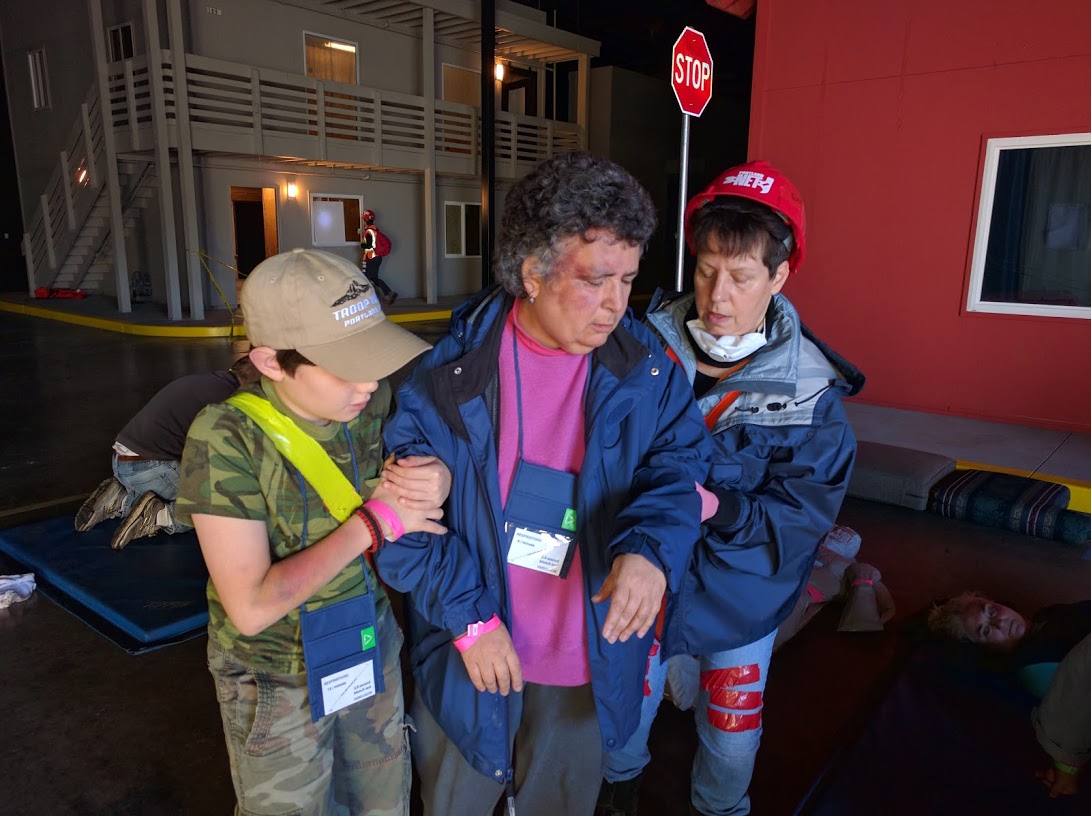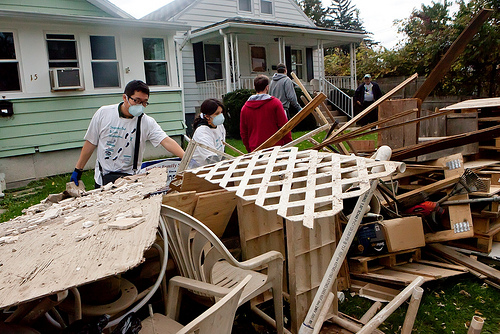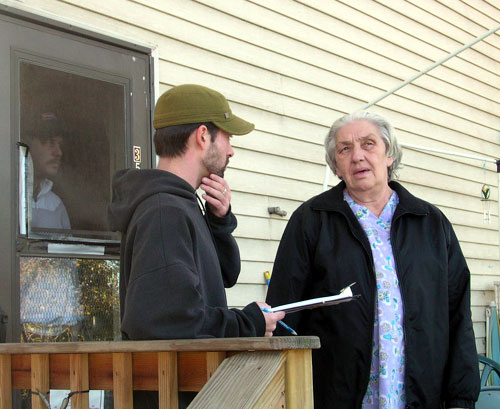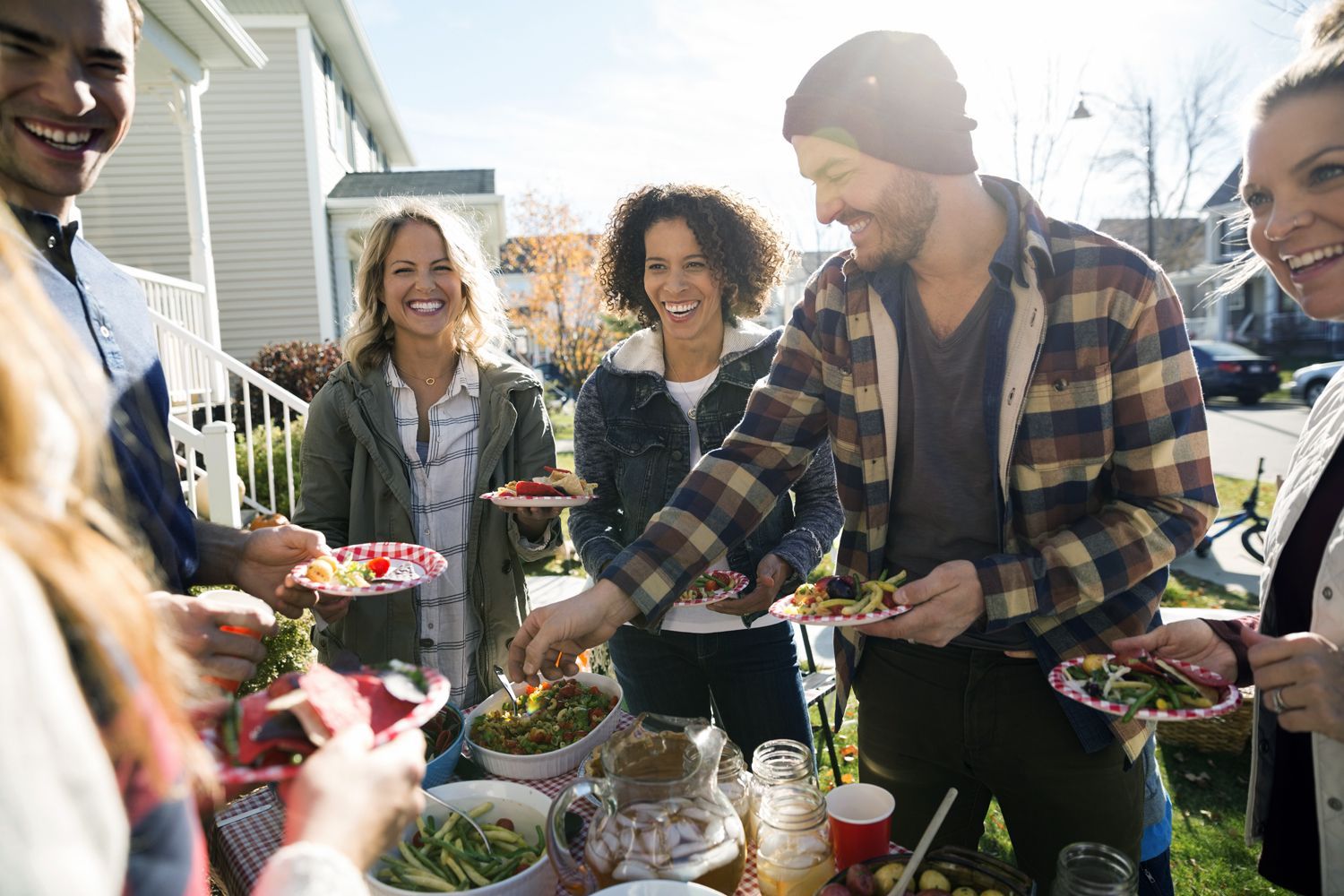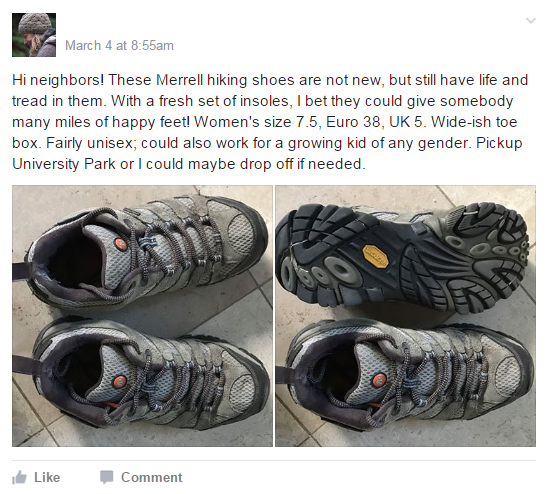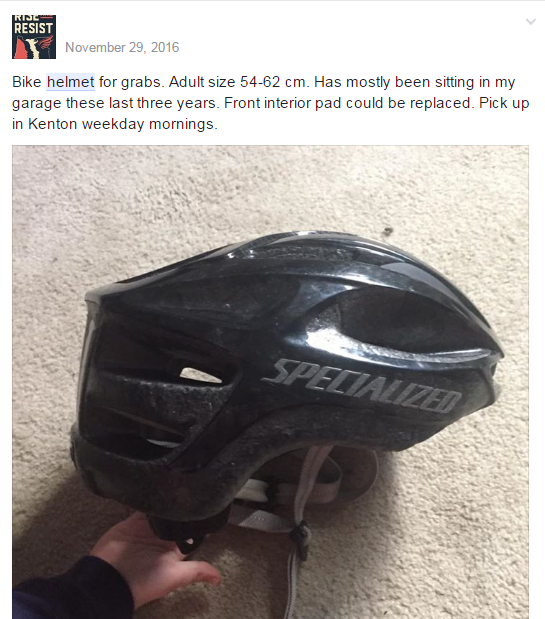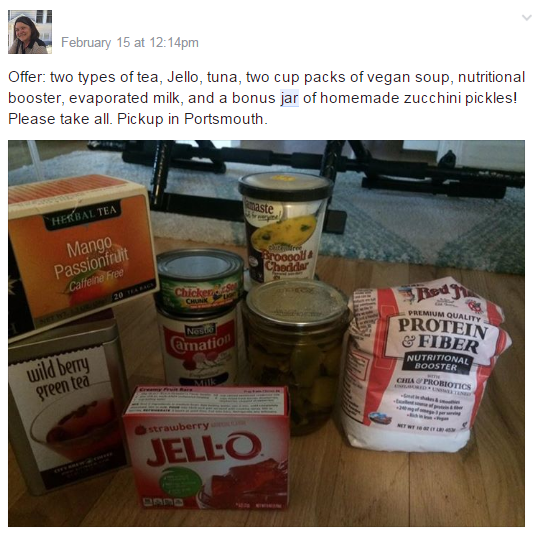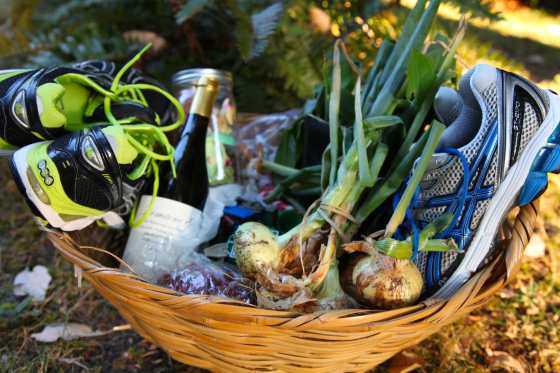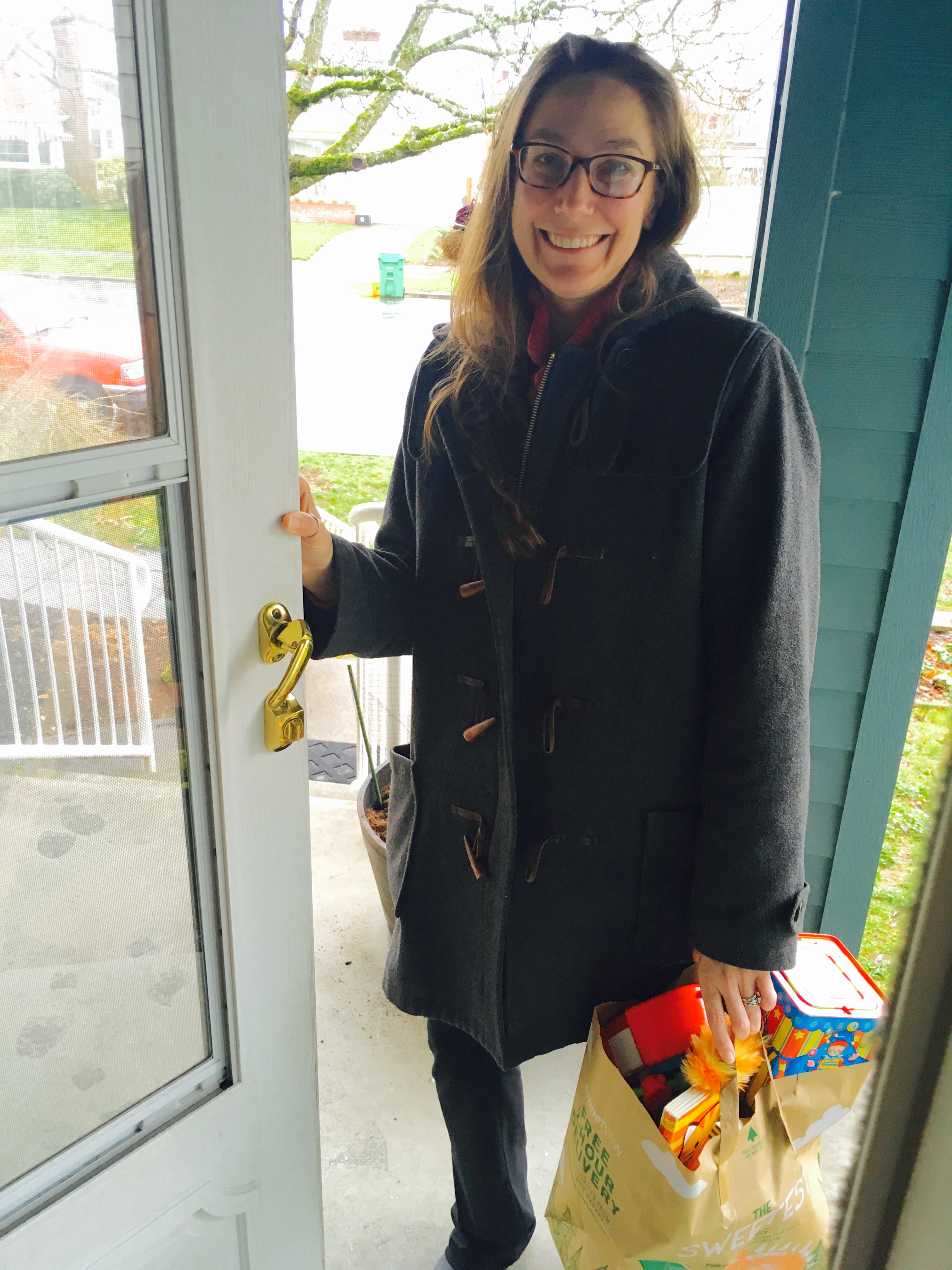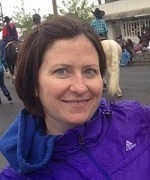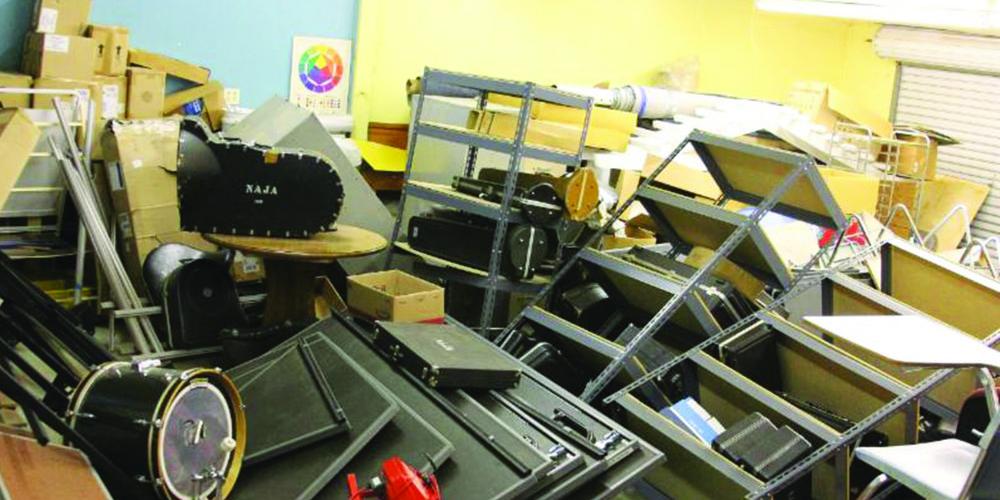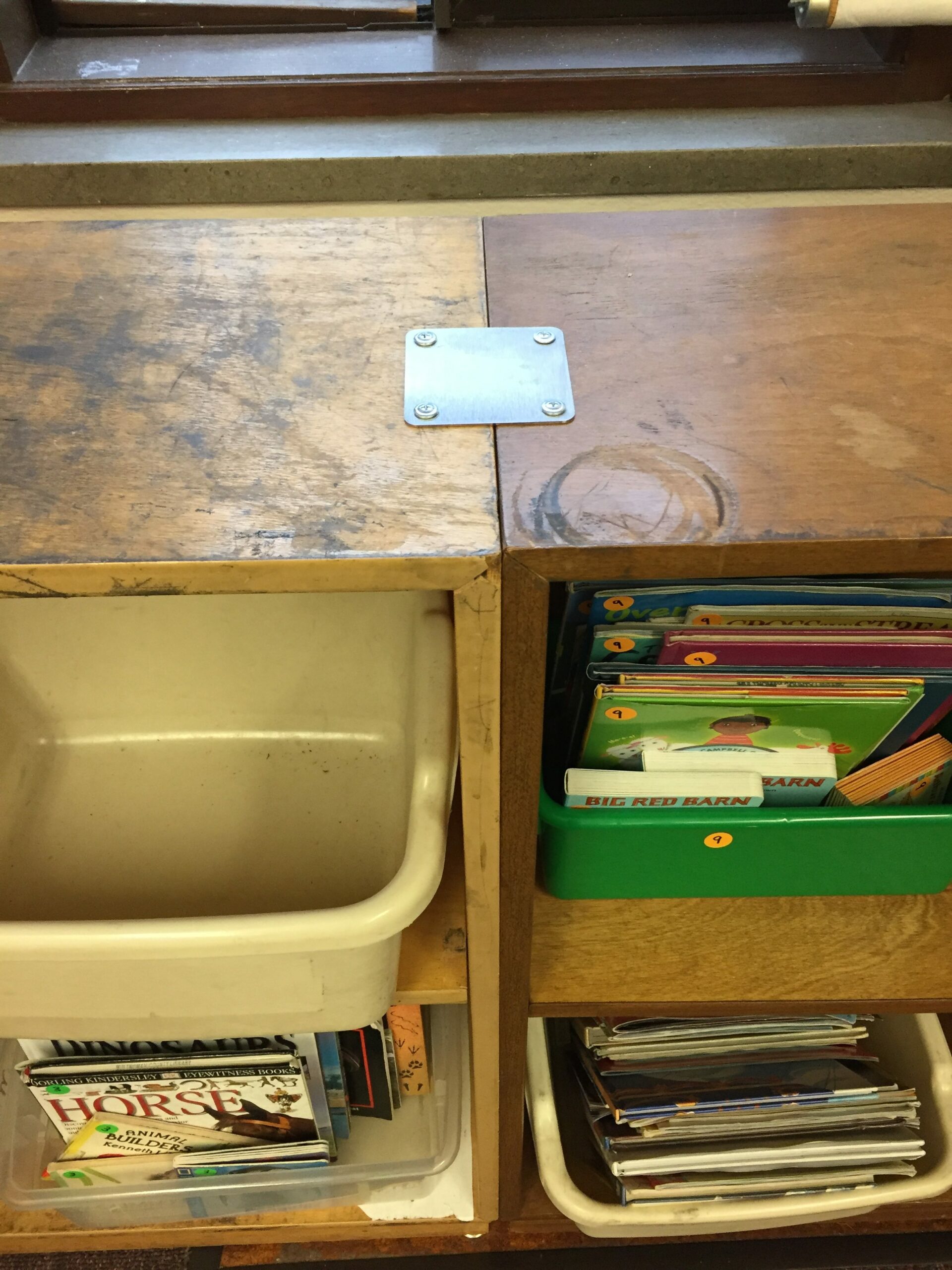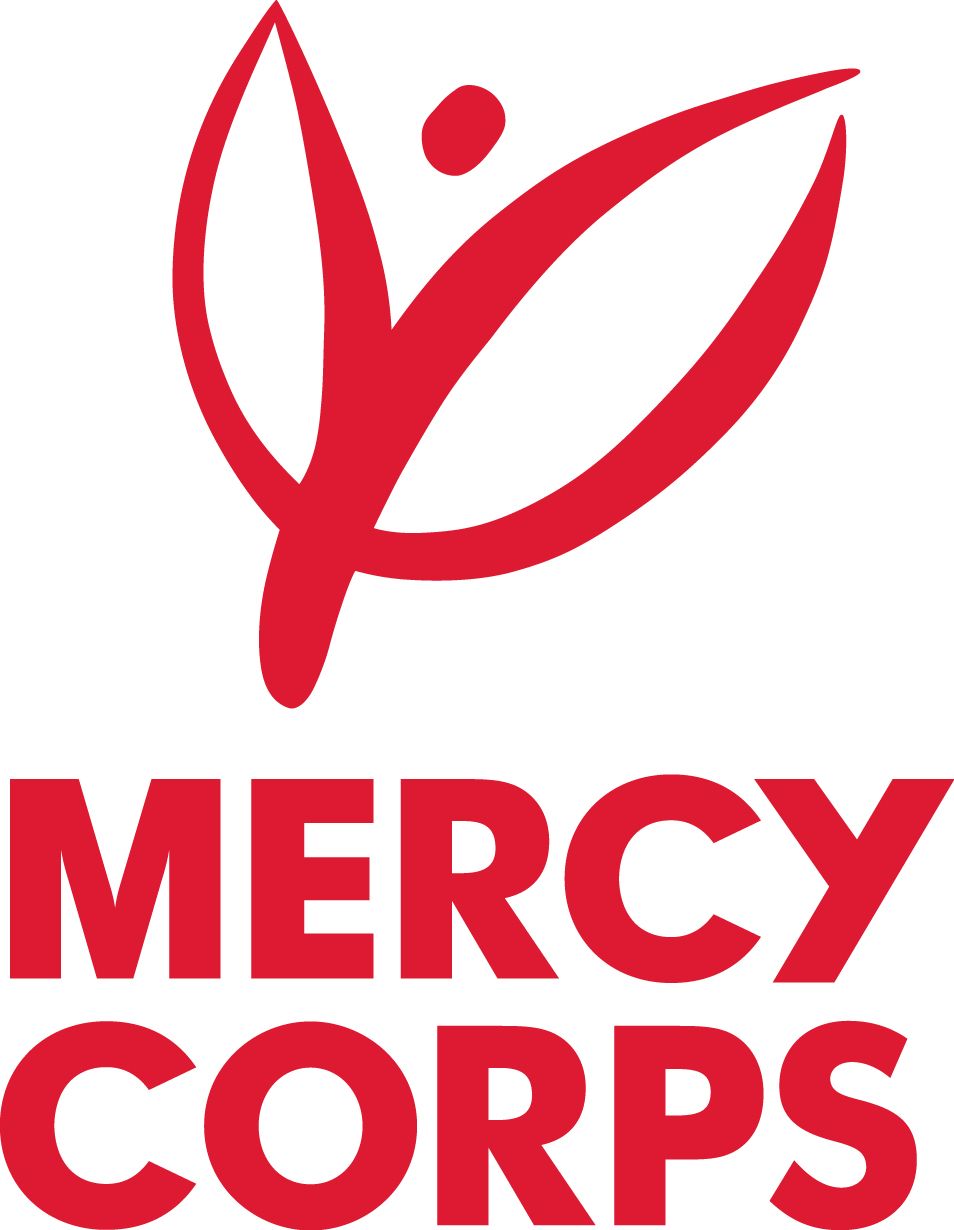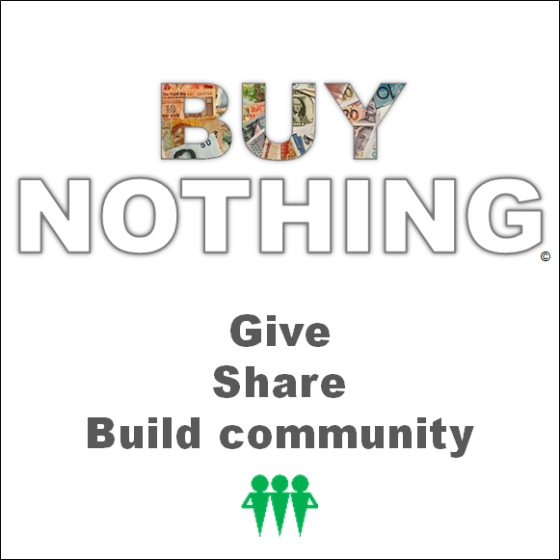
by Laura Hall | Mar 8, 2017 | Community Resilience, Kit Preparation & Planning
In the past week, three things happened that will enrich my daily life (and may come in handy after a disaster): I met a neighbor three blocks away who has kids the same age as mine, I got a free pea trellis, and I learned how to make fire cider – all thanks to a group I joined a year ago – the Buy Nothing Project. It has brought me into contact with people near me whom I would likely not have met otherwise.
What is Buy Nothing?
It’s a Facebook Group. — Wait, don’t run! — If you’re a Facebook hater, please keep reading. This might be a reason to use Facebook, even if you don’t do anything else with it.
How Does It Work?
Buy Nothing provides a structure for groups of neighbors to give or lend items they no longer need and ask for items they would like to receive or borrow. They can also give/receive services and gifts of time. Interactions begin on Facebook and continue on front porches and in living rooms. Ongoing relationships often result, and amazing acts of kindness abound.
WHAT DOES THIS HAVE TO DO WITH DISASTERS?
The four phases of emergency management are: mitigation, preparedness, response, recovery. Most disaster resources (including this blog!) focus primarily on things you can do by yourself that fall into the categories of mitigation and preparedness (like making an earthquake kit, making reunification plans, strapping your furniture, bolting your foundation, learning to shut off your utilities, and storing water).
But response and recovery are no less important, and planning for them means getting out and interacting with your neighbors. After the shaking stops, it’s our neighbors who will be there to physically and emotionally save us. After the dust settles, it’s our neighbors who will help us recover and rebuild. There just aren’t enough professional responders to “come save us.”
Living in a busy city in modern times often makes introductions and connections challenging. So how can we connect with our neighbors? Buy Nothing is one tool you may want to consider.
FACE-TO-FACE INTERACTIONS
In this semi-online, semi-offline community, true wealth is considered to be the web of relationships created between neighbors. The group encourages face-to-face interactions, and members often share stories with the group about the way those interactions have brightened their day.
Many members become friends on Facebook and in real life. Buy Nothing events have sprung up in my neighborhood. Last weekend there was a clothing swap, and the weekend before that there was a silent auction-style gift exchange with ice-breaker games and snacks. This spring there will be a Buy Nothing booth at our neighborhood cleanup event.
I often run into Buy Nothingers when I’m out in public. Sometimes I’ve met them in person, and sometimes I recognize their photo and introduce myself. I’ve only lived in this neighborhood for two years, but I already feel infinitely more connected than I did after several years of living in my former neighborhood.
SCARCITY AND ABUNDANCE
Buy Nothing creates a hyper-local gift economy. No money is exchanged at any point. Group administrators are volunteers, and they remind us that giving should not just be “haves” giving to “have-nots.” Everyone has something of value to share, and it’s amazing to see this in action. A group member who yesterday asked for toilet paper is today offering a bike he no longer needs. This highlights our community’s scarcity and abundance all at once.
While our resilience can be affected by our economic status, a strong community can mitigate the impact. I’ve seen Buy Nothing act as a community food bank and a way to keep ever-growing children clothed. And as we know, preparing earthquake kits can be challenging for community members who don’t have resources to spare. Through Buy Nothing I’ve been gifted bike helmets, water containers, backpacks, medical supplies, canning supplies, seeds, hiking boots, work gloves, and cabinet latches. I’ve seen others give and receive space blankets, canned goods, storage containers, propane fuel, tarps, buckets, flashlights, and tents.
COMMUNITY RESILIENCE IN ACTION
During our recent snow storm, one member offered free childcare to parents who couldn’t take any more time off work. Another offered transportation to those who wanted to avoid mass transit delays and/or didn’t have a vehicle with snow chains. Sidewalks were shoveled, salt was sprinkled, food was delivered, sleds were gifted, and stir-craziness was abated.
–> Last month a new mom got her bike and work bag stolen. Group members gifted her new bike panniers and a breast pump.
–> A few weeks ago, a group member gave birth to premature twins, and Buy Nothingers offered to run errands, give her postpartum items, provide emotional support, and set up a meal train for the family.
–> Last week a member asked for a ride to her citizenship test, and offers of rides, support, and encouragement rolled in.
–> Yesterday two Buy Nothingers helped another member with mobility issues by sweeping the pine needles off her roof, unclogging her gutters, and washing them out with a gutter cleaner they got from the North Portland Tool Library.
–> Today a member invited others to join him for a mending party as he works through his pile of clothing that needs patching and darning.
SUSTAINABILITY
Declutter, save money, meet your neighbors, get a new lamp shade, save the world! Buy Nothing also has an impact on our environment and cash economy. It keeps usable goods out of landfills, reduces carbon emissions, and reduces our reliance on corporations. And as Buy Nothingers share their skills, they are helping others learn to make and fix instead of toss and buy.
“Rethinking consumption and refusing to buy new in favor of asking for an item from a neighbor may make an impact on the amount of goods manufactured in the first place, which in turn may put a dent in the overproduction of unnecessary goods that end up in our landfills, watersheds, and our seas.” — https://buynothingproject.org/about
LAY OF THE LAND
I’ve noticed a hidden benefit to participating in Buy Nothing: I’m learning the physical layout of my neighborhood. As I drive, bike, and walk to my neighbors’ homes, I’m getting to know the streets and landmarks of my community. I’m sure you can see how this might be useful to a Neighborhood Emergency Team member after an earthquake.
IMMEASURABLE BENEFITS
Buy Nothing has brought me immeasurable benefits. I’ve strengthened my connection to my community, saved gobs of cash, beautified my home, added to my emergency preparedness kits, learned new skills, and felt the joy of giving. A few weeks into it, I couldn’t stop looking for items in my house to give away. A few months into it, I stopped thinking of it as a cool way to get stuff and started seeing as a way to connect with people and unplug from the system. With each passing day, my family is more resilient and therefore more prepared for all stages of a natural, manmade, or personal disaster.
There are currently 80+ Buy Nothing groups in Oregon, including 18 in Portland. As groups grow, they “redistrict” and split apart into even more hyper-local groups. To learn more, visit the Buy Nothing Project website and watch this video.
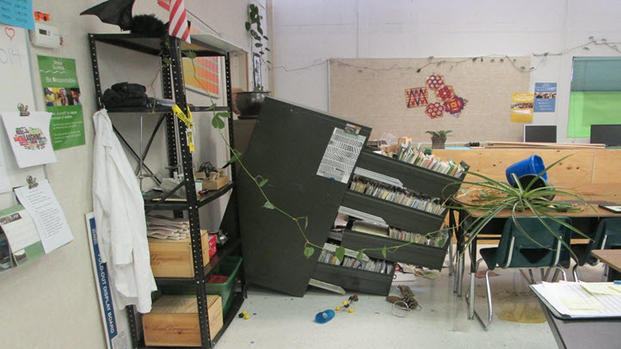
by Laura Hall | Jan 30, 2017 | Outreach, Schools
Picture this: A bookshelf packed with heavy materials located next to an exit, a large steel teacher’s desk on wheels that don’t lock sitting in the middle of a classroom, a tall filing cabinet next to student desks, folded cafeteria tables on wheels lining the walls of a gymnasium, a piano on wheels sitting in a hallway, lockers not attached to walls… Okay, now picture what happens when a 9.0 earthquake hits.
Yikes.
One of the questions I hear most frequently from my neighbors is: How are our schools preparing for a major earthquake? I can’t speak about private schools, but I can say that our public schools are doing the best they can with the resources they have – which is to say, not enough.
Portland Public Schools
Thanks to bond measures passed in 1995 and 2012, Portland Public Schools has completed seismic upgrades to many of their buildings. They also require schools to do earthquake drills twice a year, and some (but not all) schools have stockpiled emergency supplies and water. This is a good start, but it’s not enough to ensure all children’s safety during a massive earthquake.
Non-Structural Hazard Mitigation
Non-structural hazard mitigation encompasses many types of preparation, but the most relevant for this conversation is the securing of a building’s contents that could become hazardous during an earthquake – like that bookshelf by the only exit of a 1st grade classroom. Securing that bookshelf might be one of the best and easiest ways to prevent loss of life for those 1st graders.
As much as the hard-working folks at PPS would like to secure all of these hazardous items, they don’t have a budget for it. And it’s not because they don’t care. It’s because they’re faced with SO MANY other urgent issues and an incredibly restrictive budget. And because by and large, people don’t voice their concerns to administrators and elected officials about this topic.
Okay, political rant complete. Besides allocating more money, what can we do?
Parents4Preparedness
Parents, teachers, and administrators are working together to find creative solutions. The group Parents4Preparedness (P4P) was formed in 2015 by a group of concerned parents. They meet every two months during the school year to advocate for sufficient earthquake preparedness resources, promote best practices, and share information to improve the resiliency of Oregon’s schools.
These are parents who have had some successes (strapping furniture, leading parent/child reunification drills, etc.) who are trying to reach out to other parents to share what they’ve learned. Unfortunately, it’s not as simple as buying some brackets and “getting someone to do it.” There are liability issues to consider. There are schedules to consider. There are busy, busy teachers to consider. There are 100+ year old buildings with lead paint and weird materials in the walls to consider. And there are very serious equity issues to consider.
Mercy Corps Information Campaign
One of P4P’s co-facilitators, Susan Romanski, is the US Director for Disaster Preparedness & Community Resilience for Mercy Corps. Now through the end of the 2016-2017 school year, Susan is offering to do 90-minute earthquake preparedness presentations and facilitated discussions for PPS schools that request it. She’ll cover basic steps to prepare families, communities, and schools for a Cascadia event. Her presentations can be offered in English or Spanish. Here’s the catch – a parent (or group of parents) has to take this on. They need to organize the event, publicize it, and work with the school’s administration to make it happen. Parents interested in arranging a presentation at their school should carefully read this flyer.
Neighborhood Emergency Team (NET) member participation is welcome and encouraged at these events. Once an event is scheduled, the NET Team Leader in that neighborhood will be contacted, and the TL can attend the event or find someone else on the team to do it. The NET can introduce themself, share their NET experience/activities, or simply explain what NET is. This can create a bridge between the parents and the NET.
2017 Bond Proposal
Work is currently being done on a new PPS Health, Safety, and Modernization Bond proposal for May 2017. This bond is our only hope for funds that will continue to make schools safer for the next 6-8+ years. There are no other options for capital funds in the amounts needed – not from the City of Portland, the State of Oregon, or FEMA. We must persuade our friends and neighbors that these investments in safety make sense.
The first meeting with opportunity for public testimony is from 6:30-8pm on Thursday, February 2 at Madison High School. There will also be a School Board meeting on February 6 and additional town halls on February 7, 8, and 9. See the district’s bond website for details and complete this very brief online survey before February 10th.
Help Us Get the Word Out
Your help is needed in getting the word out about P4P, the Mercy Corps presentations, and the 2017 bond. We especially need to make sure that parents in underrepresented communities hear about this. So please, spread this far and wide. I know parents are overwhelmed with other issues, but this is an issue that threatens thousands of children’s lives.
Written by Laura Hall, Assistant Team Leader, Arbor Lodge / Kenton NET, ArborLodgePrepares@gmail.com
(Thanks to Ted Wolf for contributing. Ted is advocating on behalf of P4P on the 2017 bond proposal.)
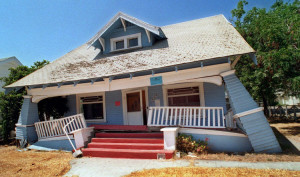
by Laura Hall | Sep 2, 2016 | Map Your Neighborhood, Outreach
How many of you live within walking distance of your friends and family? Probably not many. When the Cascadia quake hits, there will be no more internet, cell phones, or visits to friends across town. Your radius will shrink. The people in your world will be those who are actually right there near you. And there’s a good chance it will happen when you’re at home.
WHO WILL COME TO YOUR AID?

Government assistance may take weeks to arrive. Our immediate survival and long-term comfort in a disaster can depend on our connections. If your loved ones are unable to help and you don’t know your neighbors,
Who will come get you out of your collapsed house?
Who will know to look for your children or pets?
Who will put out the fire if you are not there?
Who will you band together with to share skills and supplies?
DISASTERS CREATE COMMUNITY
From that first rescue to the procuring of water, food, and medicine, we will all likely need some help. When we trade help with those near to us, we will create new close bonds based on real human needs and personal contact. We will come to know who we can trust. People will be forced to cooperate when services and supply streams fail.
BEFORE A DISASTER FORCES IT
While disasters will create communities out of necessity, having strong communities in place before a disaster is far more effective. So how can we build a sustainable community that looks out for its members? How can we function like a tribe, with personal accountability and respect? The tribes that we create around sports teams or musical preferences may be useless in the face of real adversity, but good relations with our close neighbors could save our lives.
Many of us are not comfortable knocking on doors and introducing ourselves to neighbors. We’ve become accustomed to building social bubbles and respecting others’ bubbles to the point of not knowing the person living next door. Inviting neighbors to a Map Your Neighborhood party is a good way to break the ice. You can convene around the topic of neighborhood earthquake planning and get to know each other personally in the process.
- Make it a potluck – everyone loves food!
- Do it in August – the City of Portland waives block-party fees in celebration of National Night Out (check out their great Game Ideas).
- Don’t forget to emphasize the fact that if nothing else, everyone should be stockpiling water.
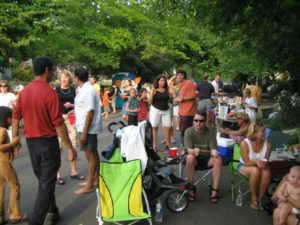
THE INTERNET CAN HELP
Social media can aid us in getting to know our neighbors. There are a number of platforms that seek to bring people together locally to convene around various topics or exchanges. Among others, NextDoor and Buy Nothing are active in Portland and worth considering.
- NextDoor.com seeks to build stronger and safer neighborhoods by providing a space for people to do things like: spread the word about a stolen car, organize a Neighborhood Watch Group, find a trustworthy babysitter, ask neighbors to keep an eye out for a lost dog, find a new home for an outgrown bike, or advertise a Neighborhood Emergency Team meeting. These online interactions often lead to in-person community building.
- The Buy Nothing Project on Facebook allows people to share good, skills, and knowledge in a format that values human connection above all else. The project’s values state, “We believe our hyper-local groups strengthen the social fabric of their communities, and ensure the health and vitality of each member… We measure wealth by the personal connections made and trust between people.”
GO SHAKE SOME HANDS
 Nothing can beat chatting with your neighbors on a regular basis. Make a point of waving and saying hello more. Make an opportunity to talk to the senior across the street about her garden. Make a double batch of muffins and go chat with the family next door.
Nothing can beat chatting with your neighbors on a regular basis. Make a point of waving and saying hello more. Make an opportunity to talk to the senior across the street about her garden. Make a double batch of muffins and go chat with the family next door.
It behooves us to prioritize people in a face-to-face way. Our most important preparedness (and happiness) goal may be to build close-proximity relationships. Long distance doesn’t help when you’re trapped under debris.
–Written by Laura Hall and Teresa Gryder
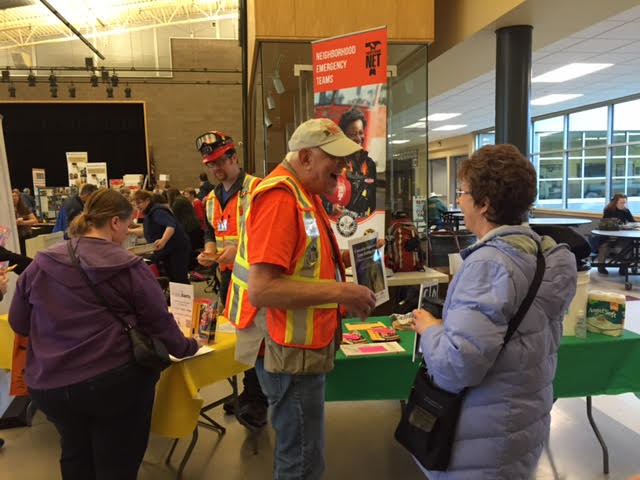
by Laura Hall | Jun 22, 2016 | Outreach
Sunday Parkways, Farmers Markets, National Night Out, Movies in the Park… It’s summer, which means it’s outreach season for Neighborhood Emergency Teams. Outreach is an incredibly important part of what NETs do. After all, we can’t help everyone, so we need to help our neighbors prepare themselves.
At the last Arbor Lodge / Kenton NET meeting, one of our talented team members (Angela Watson) presented us with this great list of tips for how to interact with the public when staffing an outreach booth.
WHY VOLUNTEER TO STAFF A BOOTH?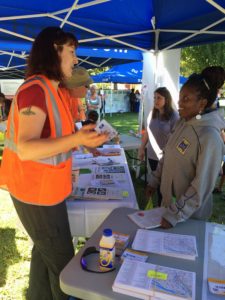
- Help your community become better prepared for a disaster and more resilient.
- Help NET by raising awareness of what NET is, recruiting new NETs, and getting donations.
- Help yourself by making new connections and earning NET hours.
WHAT DO I NEED TO DO AS A BOOTH VOLUNTEER?
- Wear your NET vest, badge, and hardhat so you’re easily recognizable as a NET member.
- Be there for your entire shift and ensure a good hand off to the next shift.
- Be visible and welcoming without being pushy.
- Speak positively about PBEM and the NET program.
HOW DO I GET PEOPLE TO COME TO THE BOOTH, AND WHAT SHOULD I SAY?
- Draw people in with eye contact, body language, and simple questions.
- Example: “Do you live in this neighborhood?”
- If YES: Point to Hazards Map and ask “Whereabouts?” and discuss nearby hazards.
- If NO: Ask “which neighborhood are you in?” and “Did you know you have a NET team?”
- Tailor the conversation to your audience.

- Do they have kids? (Discuss how their school is preparing kids and the importance of creating and practicing a family emergency plan.)
- Do they have pets? (Remind them to include pet items in kit.)
- Do they work in a different neighborhood? (Talk about importance of having a go kit and having a plan to get home. Discuss the NET team or BEECN site nearest their office.)
- Are they already a prepper or NET member? (Awesome – encourage them to get more involved in NET or start engaging with their neighbors! But avoid getting sucked into non-productive conversations that might pull you away from other folks.)
- Are they in denial about “the Big One?” (Say “It’s possible it won’t happen in our lifetime – but if you’re prepared for a subduction zone earthquake, you’re prepared for almost anything! And if it does happen in our lifetime, you’ll certainly be glad you prepared.)
- Share a personal story – Why is preparedness important to you? Were you involved in a previous disaster? What inspired you to join NET?
- Recognize that getting prepared can be emotionally and financially overwhelming.
- Remind them that it’s a process and they don’t have to do everything at once.
- Recommend starting with ONE easy, achievable thing like water storage (1 gallon per person per day).
- If cost is a concern, remind them that they probably already have many items in their home or garage. Share tips for finding supplies at a discount or making your own.
- Don’t be afraid to be a little bit crazy! (Wear a Utili-Kilt, wear a sandwich board, sing a song?!)
COMING SOON: PREPARATION, SETUP, & TEAR DOWN
Stay tuned! We’re working on a generic checklist for outreach booth logistics. It will include tips for:
- Planning your outreach
 schedule for the year
schedule for the year
- Reserving booth space
- Reserving PBEM/NET materials
- Securing raffle donations
- Recruiting volunteers
- Setting up a booth (including a diagram)
- Tearing down a booth
We’re also working on a quick reference cheat sheet for volunteers that includes, helpful links, a map of NET teams, NET team lead contact info, a list of places to get water jugs and other supplies, and talking points.
–Laura Hall, Arbor Lodge / Kenton NET Assistant Team Leader, arborlodgeprepares@gmail.com
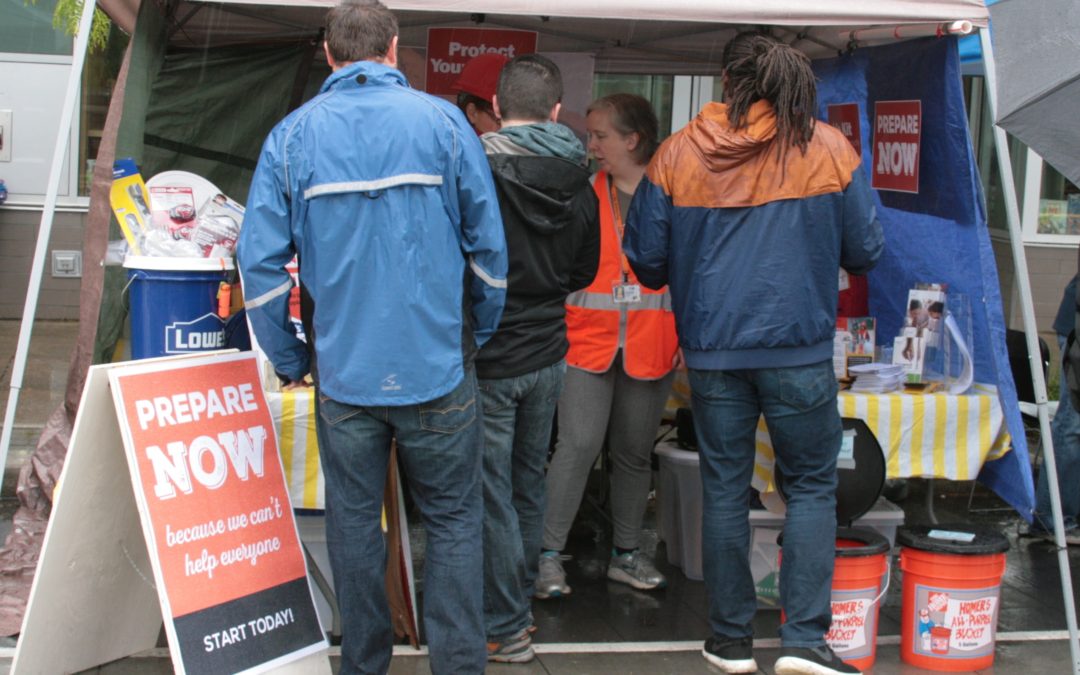
by Laura Hall | May 20, 2016 | Business Community, Outreach
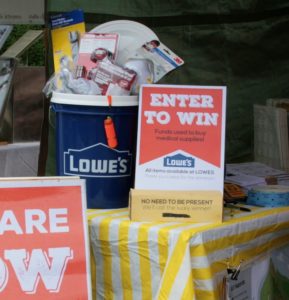 The Arbor Lodge / Kenton Neighborhood Emergency Team recently staffed a booth at the Kenton Street Fair. Our neighborhood Lowes in Hayden Island donated a bucket full of preparedness supplies, which we used as a raffle prize. It was a dreary, rainy day in mid-May, but our booth had a steady stream of visitors. At $1 a pop, we raised $60 for our team, which we’ll use for medical supplies to put in our team cache.
The Arbor Lodge / Kenton Neighborhood Emergency Team recently staffed a booth at the Kenton Street Fair. Our neighborhood Lowes in Hayden Island donated a bucket full of preparedness supplies, which we used as a raffle prize. It was a dreary, rainy day in mid-May, but our booth had a steady stream of visitors. At $1 a pop, we raised $60 for our team, which we’ll use for medical supplies to put in our team cache.
We All Win: The NET Program got attention, lives may be saved by those medical supplies, and Lowes got free advertising at our event. They also showed us that they care about the safety and wellbeing of our community.
Business partnership is something all NET and CERT teams should be thinking about. While the City of Portland funds the coordination of the NET Program, we are, in the end, non-funded neighborhood groups with a critical need for supplies and other support.
WAYS BUSINESSES CAN HELP
There are so many ways a business can help. Depending on the type of business, size, and structure, some ways will make more sense than other ways. When talking to businesses, it’s probably best just to focus on a few of these ideas instead of overwhelming them with the whole list.
In Kind Donations
Hardware stores, grocery stores, camping supply stores, army supply stores, kitchen supply stores… heck, almost any kind of store can make an in-kind donation (aka supplies). Recently the St. Johns NET Team Lead received donations from St. Johns ACE Hardware, which they raffled off at the St. Johns Bizarre.
Cash (of Course)
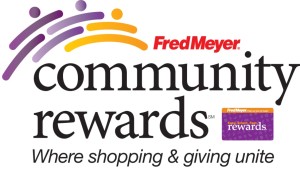 In addition to one-time, lump-sum contributions, there are also models of businesses donating cash on an ongoing basis via rewards programs. Fred Meyer’s Community Rewards Program allows shoppers to connect their Rewards Card to a NET team, which will in turn receive cash donations each month based on how much shoppers spent.
In addition to one-time, lump-sum contributions, there are also models of businesses donating cash on an ongoing basis via rewards programs. Fred Meyer’s Community Rewards Program allows shoppers to connect their Rewards Card to a NET team, which will in turn receive cash donations each month based on how much shoppers spent.
Did you know? Donations are tax deductible. We are a 501c3 organization.
Staging Area / Shelter Space
NETs are making plans for team mobilization in the event of an earthquake. Ideally, they will use a field or other open space as a staging area for their operations. But if it’s cold and rainy out, they could really use a large indoor meeting space. Businesses with a large, modern building could allow NETs to use it as a staging area or shelter after an earthquake. Identifying these types of buildings ahead of time will help immensely.
Meeting Space 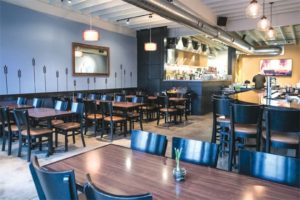
My favorite neighborhood restaurant, New American, has allowed the Overlook NET to hold team meetings in their space. Delicious local food and earthquake preparedness, together at last!
Storage Space
Many NETs are assembling supply caches, and they need somewhere to store those materials. A shed, a warehouse, a shipping container – you name it.
Promotion
Our team is talking to our local Lowes store manager about the possibility of having a NET-themed display at the end of an aisle. But it could be as simple as a flyer hung on the door of neighborhood stores.
NET Participation
 New Seasons Market takes safety and community seriously. That’s why they’re encouraging employees to ready themselves for an earthquake. They’re also working to get a few employees from each of their stores to complete NET training and get involved with local teams. Just imagine if all of our grocers did the same! Good for the business, good for the community.
New Seasons Market takes safety and community seriously. That’s why they’re encouraging employees to ready themselves for an earthquake. They’re also working to get a few employees from each of their stores to complete NET training and get involved with local teams. Just imagine if all of our grocers did the same! Good for the business, good for the community.
Preparation
Businesses can help our efforts by helping themselves. They need to educate and train employees, consider hazards in their work space, and plan for continuity of business. The NET Program is working on a way to provide support in this planning. In the meantime, resources such as Open for Business and Prepare My Business have helpful handouts and other resources.
ANYONE CAN DO IT
 You may be thinking: “I don’t know how to solicit donations!” In the case of Lowes donating a bucket full of supplies, it was as easy as one of our team members walking in the store and talking to a manager about the work we do. You’d be surprised how willing most businesses are to contribute. Sometimes all you have to do is ask!
You may be thinking: “I don’t know how to solicit donations!” In the case of Lowes donating a bucket full of supplies, it was as easy as one of our team members walking in the store and talking to a manager about the work we do. You’d be surprised how willing most businesses are to contribute. Sometimes all you have to do is ask!
You may also be thinking: “I don’t know anything about business preparedness!” South Burlingame NET has prepared a terrific form that you can use to open a conversation with a neighborhood business.
You don’t have to be a NET member and you don’t have to be a preparedness expert to talk to neighborhood businesses.
Just tell them that you’re a concerned community member and that you can put them in touch with the Team Leader for your neighborhood’s team. They can also complete our online donation form or contact form, which will be routed to the appropriate person.


